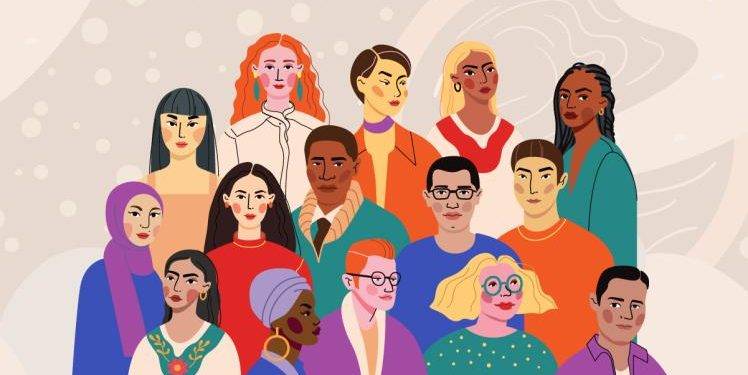DEI programs have often worked to get underrepresented employees involved in its efforts because they have lived experiences. They can bring their perspectives to the table and help to enlighten other coworkers on diversity and inclusion topics that they may not understand or be aware of. Yet, this has become a less favored approach in recent years.
One, it puts the onus on the person of color or minority to do the educating, which isn’t right or fair. While it’s okay to invite people to share, making it their duty to explain, educate, or voice issues is problematic.
Second, it makes it seem like only some voices are important in the conversation. Today, a much more favored approach is “DEI for All.”
DEI for All
Companies are now inviting as many employees as possible to get involved in DEI. They don’t care if their identities are traditionally overrepresented or not. They no longer want people to see a diversity and inclusion event and think it’s “not for them.” Now, their diversity and inclusion programs will favor an “all-hands-on-deck” approach.
That said, this doesn’t mean that underrepresented folks aren’t highly valued. As much as these employees are willing and able to help, they will be welcomed with open arms. However, this type of DEI program does recognize that it isn’t entirely up to them. Everyone has ears, and we all can listen. Everyone has a voice, and we can all speak (when appropriate — and preferably after listening!).
Is It Okay to Have White Leaders in “DEI for All”?
This is a tough question to answer. Part of having a good DEI program is “decentering whiteness.” White employees must check their privilege at the door and understand that they are there to listen and learn. This space wasn’t created for them, but they can very much participate and support.
In some organizations, it will be necessary to have white leaders step into a role like Chief Diversity Officer simply because of the available candidates. Such non-traditional DEI leaders can be the right choice, and it’s equally as important to recognize when an organization is simply overlooking a qualified candidate because they have “overrepresented” social identifiers. When this occurs it’s counterproductive to diversity, equity, and inclusion efforts.
Final Thoughts
It can feel a bit awkward to navigate the correct roles for people in a DEI program. Many people want to be “color-blind” in a hiring process, but this is counterproductive to diversity and inclusion efforts. When possible, POC are often the best fit for DEI department team members, but you shouldn’t exclude white employees simply because of their race or other identifiers. DEI for All is a new and growing approach that says everyone deserves a seat at the table — allies as well! Try an online diversity training for employees to highlight important areas of diversity.
For a couple of easy steps to get your DEI program off the ground, check out our Diversity Calendar or Diversity Training program.
Should White People Serve as Chief Diversity Officers?
It’s an interesting question, and most people don’t know how to navigate it. Diversity training programs were initially started to help employees adjust to working in more integrated offices. Although many executives look at DEI programs as a strategic play for the company, diversity can bring value in numerous ways.
Amid calls for a “Diversity for All” approach, here’s what you should know about whether white people can effectively serve as Chief Diversity Officers or if the role should be reserved exclusively for POC.
What Does a Chief Diversity Officer Do?
A chief diversity officer ensures that an organization’s culture values diversity, equity, and opportunity. Any company can use a CDO if they want to be more inclusive and change the way they operate (particularly more fairly).
The role of Chief Diversity Officer is still growing, but it first rose to relative prominence in the early 2000s.
Advantages and Disadvantages of White CDOs
When most people think of putting a non-POC in the position of Chief Diversity Officer, they think of the poor optics. Diversity programs were originally created to navigate integration in offices, and they have primarily worked with people of color in the past. As a result, the idea of putting a white person in charge of this program seems a bit out of place. However, there are some advantages to doing some in specific situations.
Advantages
- Allies should do the bulk of the work when educating folks from privileged groups because it takes a toll on individuals from marginalized groups
- White CDOs are often a good fit at PWIs because they are received differently and may also be less defensive when challenged by fellow white people, which could lead to better dialogue about race
Disadvantages
- It doesn’t provide a role model for any employees of color who may need to see someone who represents their identity in a leadership role
- Even well-intentioned white people may miss micro or macro racial aggression without the help of people of color
Can DEI Truly Be for All?
In 2023, there’s a new trending approach of “DEI for All.” While underrepresented voices have previously been more valued in the conversation surrounding diversity and inclusion, companies no longer want their voices exclusively. They want to bring all employees to the table.
This “all-hands-on-deck” approach allows everyone to have buy-in and thus increases the chances that initiatives will be successful. That said, not everyone’s roles will be the same. White employees will need to remember that this space wasn’t created with them in mind. They should always listen before speaking. They should then uplift and support their fellow underrepresented employees whenever possible. If they have something important to add, they can do so after others’ voices have been heard, but it’s important to refrain from speaking to fill the space.
Final Thoughts
Diversity for All can be a challenging transition, especially if your company previously adopted an approach that favored no white employees in DEI committees or leadership. Be open-minded, listen before speaking, and uplift others when possible.
For a couple of easy steps to get your DEI program off the ground, check out our Diversity Calendar or Diversity Training program.













